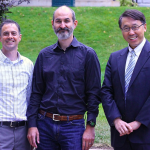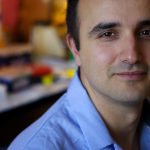Intrahepatic cholangiocarcinoma (ICC) is the second most common kind of liver cancer. It is a very difficult disease to treat. Only about one out of ten patients live more than five years after the cancer has been detected. There are several different types of ICC. One important type has changes in a gene called the Fibroblast Growth Factor Receptor 2 (FGFR2). Drugs that turn off FGFR2 cause the tumors to shrink, but the tumors eventually become resistant to the drug and begin to grow again. The goals of this project are to understand what causes drug resistance and to develop ways to prevent it from happening. In this project, we will study samples of tumors from patients who are being treated with drugs against FGFR2. We will also make models that allow us to study ICC in the laboratory. Finally, we will use a method that could allow us to create a new kind of drug that is better at turning off FGFR2. We hope that our work will result in new treatments that help patients with ICC to live longer.
State: Massachusetts
Mo Motamedi, Ph.D.
Almost all cells of an individual share the same genetic information. Yet each individual has many different cell types with distinct characteristics and functions (e.g. skin cells and brain cells of the same individual are indistinguishable genetically). One the most vexing questions in biology is: how is this dizzying array of cell types made within an individual, all of which come from the same blueprint of genetic information?
We now know what differs among the different cell types of an individual is not the genetic information; instead, it is the ‘on’ and ‘off’ state of genes in that cell type. In other words, a cell’s unique gene expression signature determines its characteristics. A molecular memory system, called epigenetics, establishes and remembers the cell type’s unique gene expression pattern during development.
One way by which cells become cancerous is by losing their ability to remember who they are. This also impairs their ability to protect their DNA against damage and instability. Recent work has revealed the identity of some proteins whose job is to regulate these important processes. We have found that two of these proteins work together to create a special DNA structure, which protects our DNA against instability and remembers if a gene is ‘on’ or ‘off’. We plan to understand the mechanism by which these and other proteins regulate gene expression and genome stability. This work impacts our basic understanding of many different cancers, and will likely allow the development of new drugs and new strategies for killing or reprogramming cancer cells.
Judy Garber, M.D., MPH
Funded by 2017 BRCA Fund-A-Need
The goal of this project is to provide women with BRCA2 mutations with a better option for reducing their risk of breast cancer while managing the menopause symptoms caused by removal of their ovaries. After ovaries are removed, BRCA2 carriers must balance management of menopause symptoms against high risk of primarily hormone-driven breast cancers, without much data about the long-term safety of hormone replacement. A new combination of bazedoxefine,a tamoxifen-like medication, and conjugated estrogen (BZA/CE or Duavee® ), has been extensively studied in postmenopausal women (without mutations) with established safety data . BZA/CE should reduce breast cancer risk without compromising quality of life for BRCA2 carriers by causing menopausal symptoms, bone loss or uterine problems. The randomized clinical trial compares BZA/CE to CE alone for 3 months in women carrying a BRCA2 mutation soon after ovary surgery. Their breast tissue will be examined to assess whether, as predicted, the BZA/CE has protective effects against breast cancer compared to the CE alone. After 3 months, the study is unblinded so those on CE can take a short course of progesterone. The exciting part of the project is all of the novel science that will be applied to assess the action of BZA/CE and CE on normal breast tissue in women with BRCA2 mutations. This has not been very well-studied, and is critical not only for breast cancer prevention but also for potential therapeutic implications for the cancers BRCA2 mutation carriers can develop.
Nikhil Wagle, M.D.
V Scholar Plus Award – extended funding for exceptional V Scholars
Estrogen receptor positive (ER+) metastatic breast cancer (MBC) remains the most common cause of breast cancer death. Though we have made many advances in the treatment of ER+ MBC, patients invariably develop resistance to therapies. The mechanisms of resistance are not well known. In order to improve survival for patients with ER+ MBC, it is critical to develop an understanding of this resistance.
We recently found that in 7% of metastatic tumors from patients with resistant ER+ MBC, a gene called the retinoblastoma tumor suppressor (Rb) had been deleted. Loss of the Rb gene resulted in resistance to multiple agents used for ER+ MBC. ER+ MBC that lacks Rb likely represents a growing subset of patients in whom standard therapies do not work and in whom we do not know the optimal therapies. Therefore, it is critical to develop novel approaches to treating this subtype of ER+ MBC.
The goal of this research is to better understand Rb loss in ER+ MBC and identify new therapeutic strategies. To do this, we will utilize cell line models we have generated that approximate ER+ MBC that has lost the Rb gene. We will characterize these cell lines to identify how they become resistant to therapies, and identify novel therapeutic targets to prevent or overcome this resistance. At the completion of the project, our results should enable the development of clinical biomarkers of response and resistance for patients with ER+ MBC, and, ultimately, the design of clinical trials of therapeutic approaches and rational drug combinations.
Eliezer Van Allen, M.D.
Funded by the 2016 V Foundation Wine Celebration Fund-A-Need for Prostate Cancer
Nearly all patients with metastatic castration resistant prostate cancer (mCRPC) develop resistance to androgen targeting agents and ultimately succumb to their disease. Recent discoveries by our group and others have demonstrated that a significant proportion of these patients harbor somatic or germline genomic defects in DNA repair defects, and targeting this genomically defined subset with therapies affecting this pathway may impact patient care. The goal of this project is to definitively characterize the genomic and functional landscape of DNA repair defects in mCRPC, clinically test the hypothesis that tumors harboring DNA repair defects preferentially benefit from immune checkpoint blockade, and explore innovative strategies to augment the efficacy of these agents through genomic and preclinical approaches. The project described herein is the first to comprehensively bridge the DNA repair and immuno-oncology fields to directly impact patients with advanced prostate cancer. We propose an integrated strategy that leverages advances in clinical genomics, trial design, and preclinical modeling methodology pioneered by our team. Furthermore, our proposal will be the first to specifically enable immune checkpoint blockade treatment strategies for mCRPC. In summary, this project will catalyze our understanding of how DNA repair defects impact advanced prostate cancer, and how deep knowledge about these events may enable clinical development of a transformative new class of immunotherapies that are greatly needed for advanced prostate cancer patients.
Miguel Rivera, M.D.
V Scholar Plus Award – extended funding for exceptional V Scholars
Ewing sarcoma is the second most common bone cancer in children and is a very aggressive cancer with a rate of survival of only 60-70%. One important path to finding new treatments for this disease comes from the fact that all Ewing sarcoma cases have an abnormal fusion protein known as EWS-FLI1 which activates genes that drive the formation of tumors. In a prior study we characterized the genes that are activated by EWS-FLI1 in Ewing sarcoma and identified the kinase VRK1 as a promising new therapeutic target. We have also demonstrated that inactivation of VRK1 results in a strong reduction of Ewing sarcoma growth. In this proposal our goal is to characterize the role of VRK1 in Ewing sarcoma and to better understand the mechanisms that regulate its expression in these tumors. These experiments will validate the potential of VRK1 as a therapeutic target and will point to molecular pathways that account for its importance in this disease.
Roberto Chiarle, M.D.
Funded by Bristol-Myers Squibb
Neuroblastoma is the second most common tumor in childhood accounting for 7% of all children with cancer. There are about 800 new cases of neuroblastoma each year in the US. Treatments for neuroblastoma include surgery when tumors are localized or chemotherapy and radiation therapy when tumor spreads to other parts of the body. Cure rates are high for low-risk children, but only about 50% for high-risk children such as those whose tumor has spread. For these reasons, neuroblastoma is still the deadliest cancer in the childhood. With our research we aim at increasing the cure rates of neuroblastoma, particularly in high-risk children. To achieve this goal, we will harness the immune system of the children by instructing their lymphocytes to specifically identify a molecule called ALK in tumor cells. To obtain the highest potency and accuracy, we will exploit not only one immunotherapy, but rather a novel dual immunotherapy that will combine a cancer vaccine with engineered lymphocytes, both primed to recognize the same ALK target on tumor cells. This novel concept of dual immunotherapy will be tested in mouse models of neuroblastoma and will provide essential information on how the immune system can be exploited to target this tumor. These findings will lay the foundation for future clinical trials that will exploit this dual immunotherapy approach in children.
Steven Barthel, Ph.D.
V Scholar Plus Award – extended funding for exceptional V Scholars
It is now clear that our immune system has the capacity to both recognize and destroy cancer cells. Unfortunately, tumor cells escape this immune-mediated destruction by activating inhibitory switches to turn off T-cells. These switches, called immune checkpoint receptors (ICR), are now being targeted in early-phase clinical cancer trials in hopes of restoring and boosting immune-targeted killing of cancer.
However, despite showing promise in animal models of cancer, it remains unclear whether drugs targeting more recently identified ICRs will work in humans. Most importantly and a major focus of this proposal, while ICR therapies were previously assumed to bind and target only immune cells as noted above, our data newly identifies ICR expression directly on cancer cells along with therapeutically promising anti-cancer as well as pro-tumorigenic activities. What’s more, levels of cancer cell-ICRs could be dynamically regulated by cytokine stimulation. Overall, these findings raise unanswered questions on ICR-specific drug safety, specificity, potency and optimization that challenge existing, even false, assumptions within the immunotherapy field and invite further inquiry of these entirely unexplored tumor-intrinsic pathways.
This interdisciplinary proposal functionally dissects one particular tumor cell-expressed ICR and its undiscovered roles in cancer progression. As our seminal data reveals that it powerfully regulates cancer growth and metastasis, this research lays the groundwork for developing innovative drugs to block cancer advancement. Results will not only raise awareness of unanticipated impact of ICR drugs on a new tumor-intrinsic pathway but also invite further scientific and therapeutic inquiry and exploitation of this undefined pathway in cancer.
Philip Kranzusch, Ph.D.
Abeloff V Scholar*
A new form of treatment for cancer is to activate a patient’s own immune system to recognize and destroy tumor cells. Called cancer immunotherapy, this strategy has proven to have a remarkable impact on long-term survival for patients with a wide range of cancer types, but only a subset of individuals has sustained responses that can lead to a long-term cure. In order to advance cancer immunotherapy, it is critical to understand the immune signals responsible for robust tumor immunity.
One key part of the immune response to cancer is a cellular protein named STING (Stimulator of Interferon Genes) that allows immune cells to detect DNA derived from tumors. STING naturally responds to drug-like small molecules, and an exciting new area of study is the idea of “STINGing cancer” – using compounds that specifically activate STING to boost tumor recognition and patient responses to cancer immunotherapy. In spite of the clear role of STING in immune cell responses, STING signaling is poorly understood and we do not understand how signaling leads to improved patient responses.
Our research will determine how STING transmits signals to the immune system and which STING signal is critical for combating cancer. These experiments will provide the foundation for the design of next-generation drugs that target STING and, ultimately, will help us understand how to use cellular proteins like STING to better control human immune responses and treat cancer.
Michael Birnbaum, Ph.D.
Scientists have recently made tremendous progress in treating cancers by activating the immune system to attack the tumor. However, these therapies are not effective against cancers with less DNA damage due to insufficient anti-tumor immune responses. The immune system is capable of attacking these tumors, but suppressive immune subtypes such as regulatory T cells (Tregs) are coopted by the tumor to protect itself. Tregs are associated with poor survival in many cancers, and show enrichment for particular T cell receptors (TCR). The TCR senses targets by binding to their peptide-MHC ligands, which display a cross-section of peptides expressed by a particular cell. Despite their important role in protecting tumors, the identity and specificity of tumor-resident Tregs is poorly studied. We are working to profile what T cells are enriched in low mutation rate cancers. We can then use approaches we have developed to find what these T cells as seeing in the tumor. This information will help us understand of one of the most important tumor-protective cell types, and may open the door to new cancer immunotherapies.













